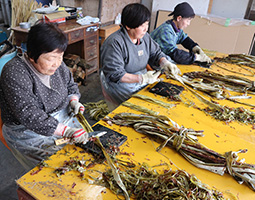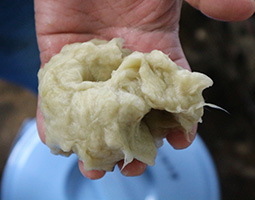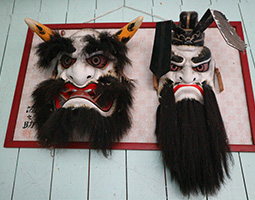March 2020
Sekishu-banshi: Supporting Culture and Art

Sekishu-banshi, a famous washi paper from Shimane Prefecture with more than 1,300 years of history, supports culture and art both within Japan and abroad.
Sekishu-banshi has continued to be produced for more than 1,300 years in the Iwami region centered around Hamada City, Shimane Prefecture, and it was registered on the Representative List of the Intangible Cultural Heritage of Humanity in 2009. Later, it was registered again in 2014 as “Washi, craftsmanship of traditional Japanese hand-made paper,” together with honminoshi (Gifu Prefecture) and hosokawashi (Saitama Prefecture).
Sekishu-banshi is made through a traditional technique that adds a viscous liquid taken from aibika root to the delicate, long fibers of locally-grown kozo paper mulberry trees. The paper’s characteristics come from the fact that the endocarp, a part of the tree between the bark and the tree core, is used, while this is removed in the washi paper production of other regions. Because of this, the finished washi has a unique luster, a texture with a faint green tint, and is quite strong. This is why it spread across Japan during the Edo period (1603–1867) as a practical kind of paper, used for such things as writing paper for calligraphy, account books for shops, umbrellas and toys.



However, though there were over 6,000 producers, their numbers were reduced due to the spread of machine-made washi and a decrease in demand during the Meiji period (1868–1912), with only four producers left today in the Misumi area of Hamada City. Nishida Seigi is the seventh generation of washi producers at Sekisyu-Washi and also head of the Sekishu-banshi Craftsmen’s Association, which is made up of the remaining four producers. He says, “All four producers are blessed with having successors, so it looks like we can continue on with the next generation.”
In recent years, the number of farmers and specialty merchants cultivating kozo trees has decreased, and each washi producer must now handle all processes, from cultivating the materials, to harvesting, processing and sales. “The conventional division of labor that has supported the manufacturing of washi is changing. However, sekishu-banshi is widely used in the masks and costumes of actors and on the stage for Iwamikagura, which has been passed down since ancient times in this region. Even today, there are over 100 groups that perform Iwamikagura, and we are supported by this demand. It is an ideal form of local production for local consumption for traditional art and traditional craftsmanship.”

Additionally, more than 60% of the products made by Nishida are used in repairing cultural assets. Damaged parts of paintings and books are strengthened by attaching washi and through other processes. Sekishu-banshi is used to repair historical fixtures and cultural assets such as at the Shosoin treasure house in Nara, Hongan-ji temples in Kyoto, and Nagoya Castle. Recently, washi has come to be used in the repair of Western artwork and important documents, with many orders coming from art museums around the world with Japanese art collections, including the British Museum and the Museum of Fine Arts, Boston.
Wishing to actively respond to this global demand, Nishida participates in paper trade shows both at home and abroad with others from the Craftsmen’s Association. Additionally, he works to popularize sekishu-banshi using the Sekishu Washi Kaikan, built locally in 2008, as a base. Sekishu-banshi producers began an international exchange program in the 1970s, accepting researchers from the Kingdom of Bhutan and elsewhere, working together to improve manufacturing techniques for handmade paper overseas. Members of the Craftsmen’s Association take turns working as instructors for washi-making workshops held at the Sekishu Washi Kaikan for locals and tourists.
In addition to these activities, Nishida also collaborates with a variety of artists, creating a wide range of products, including single-flower vases, coasters, cushions and lights.
Nishida, who is rediscovering the charm and potential of sekishu-banshi, says, “Sekishu-banshi still exists precisely because our predecessors used locally-produced materials and continued the traditional manufacturing methods. I am taking on new challenges, such as developing unique products, while also holding on to the basics. When collaborating with other artists, I discover unexpected expressions through washi, and I am surprised quite often.”

